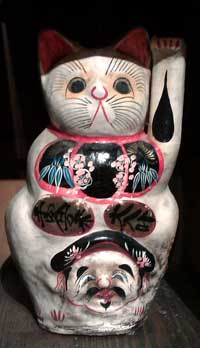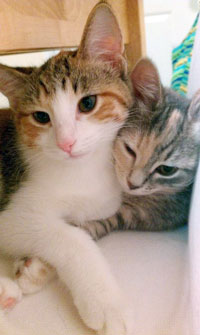Hi-ho, neighbors! Did you catch last week’s brand-new episode? Listen to “Lousy with Diamonds,” see its show notes, or download the MP3.
Among many other things, we talked about money cat. It’s what a Mainer might call a calico cat. The idea goes back to a bit of folklore that calicos bring you good luck.
Suzanne Taylor wrote to tell us that in her usage, it’s only the male calico cats which are money cats because they’re the rarest of the rare. She also sent us pictures of her cats:
We also received a very informative email from Lauren Debussy in Dallas, who reminded us about the maneki neko “beckoning” cats, which originated in Japan but now can be found throughout Asia. They’re also used for luck.

Photo taken at the Mingei International Museum’s Maneki Neko exhibit.
She also taught us the term torbie, which is a tortoiseshell cat that has tabby stripes.
Relearning A Language
Let’s say a child lived in a place where she learned and spoke a language other than English. Then she moved to an English-speaking country. She learned English and seemed to forget a lot of what she knew of her mother tongue.
Would she be starting from scratch if she tried to relearn that first language years later?
That’s the question we answered from a caller this past weekend. Hear his story.
Grant responds with information from Terry Kit-fong Au, a professor at the University of Hong Kong, in the book Access to Language and Cognitive Development.
In the chapter, she explains a study of children who learned a bit of Spanish or Korean as children but then had a gap in their lives where they had no exposure to it at all.
She found that even after a gap of seven or more years, children had a much easier time relearning their first language than did students who had never been exposed to the language. The relearners also spoke with something more like a native accent.
Quick Answers
Our Facebook page grows by leaps and bounds, with new questions and discussions posted all the time. Here are a few of the recent ones.
• Is step-ins regional? Anne writes, “I am in a Facebook discussion about when the term ‘step-ins’ came and went as a term for women’s underwear, and whether there was a regional aspect. I am a boomer with a long memory and I’m pretty sure I’ve encountered it only in fiction.”
We talked a bit about “step-ins” in this episode. Looking in the last volume of the Dictionary of American Regional English (not published at the time of that episode), we see no entry for “step-ins,” which means there probably is not a regional component.
It’s old-fashioned and perhaps more Southern, though, and it appears to have been used in the era in which it was okay to talk about undergarments but just not in a specific way.
• Lois wants to know where “if wishes were horses, beggars would ride” comes from.
Alas, it’s so old, there’s no way to know who said it first, but here’s a version of it from A Collection of English Proverbs published in 1670! It also gives an archaic French version, “Si souhaits furent vrais pastoureaux seroyent rois,” or “If wishes might prevail, shepherds would be kings.”
• Redd up. Karen writes, “I spent my first 18 years in western Pennsylvania, just north of Pittsburgh, so I enjoyed the podcast from last weekend talking about nebby as in ‘nebby neighbors.’ A few weeks ago there was a discussion on ‘redding up the house,’ words I grew up with. My daughter remembers her grandma telling her to go into the front room and sit on the davenport and Heather had no idea where she was supposed to go or what to sit on.”
We’ve talked about “redd up” a few times, and while it’s not specifically a Pennsylvanian word, it is well-known there.
As for davenport, it’s noticeably more common in the Great Lakes states, and in Pennsylvania, according to a map in the Dictionary of American Regional English. DARE defines it as “an upholstered couch or sofa, sometimes convertible to a bed.”
Evan Morris, The Word Detective, wrote about names for this type of furniture in 2009.
Here’s an interesting tidbit about how C.S. Lewis cleverly used his understanding of etymology for the different terms.
Let us consider the five most common options Lewis had for labeling the piece of furniture: couch, davenport, settee, sofa, and divan. Couch comes from French; davenport comes from the British maker’s name; settee comes from Anglo-Saxon; sofa and divan come from Turkish. Since this scene has a Middle Eastern setting, Lewis avoids the word choices from a Western European background and uses the two words of Middle Eastern derivation. That’s impressive.
• Please give if you haven’t yet.
Peace and love and thanks,
Martha and Grant
Photo by Blek (Black_Claw). Used under a Creative Commons license.





